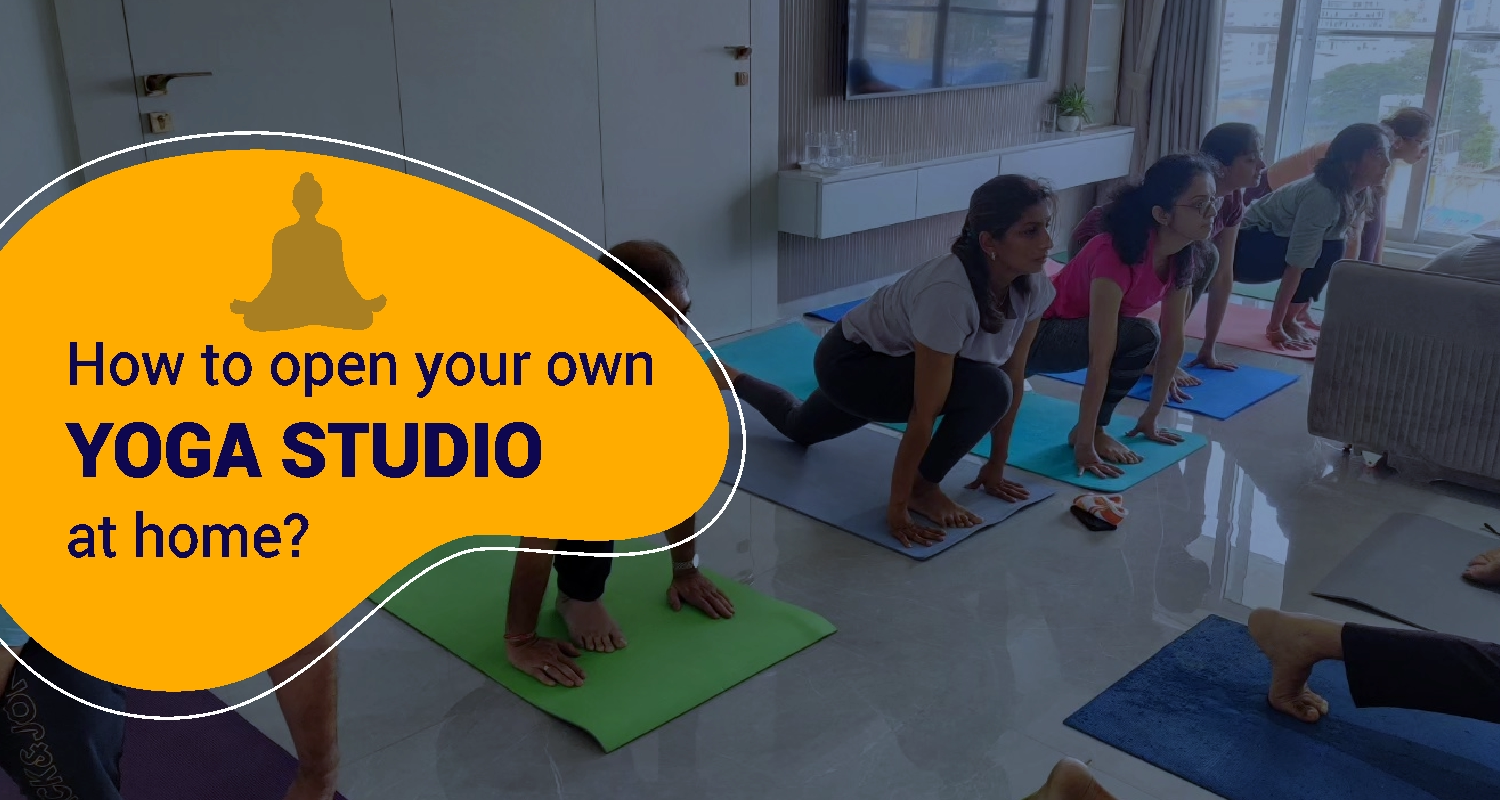10+ Steps to Start a Yoga Business From Home

Opening a yoga studio at home can be a fulfilling journey that allows you to share your passion for yoga while maintaining a flexible schedule and a manageable overhead. With yoga’s rising popularity, more people are seeking personalized, convenient spaces to practice, and home-based yoga studios offer the perfect solution. In this guide, we'll walk through how to start a yoga studio at home, including tips for space planning, branding, marketing, and growing your business to achieve desired results.
1. Clarify Your Vision for the Yoga Studio
The first step in opening a yoga studio is having a clear vision for what you want to achieve. Are you targeting beginners, advanced practitioners, or a specific niche like prenatal yoga or restorative yoga? Having a focused approach will help you define your business model, class offerings, and overall ambiance.
Questions to Consider:- What type of yoga will you specialize in?
- How many students can you accommodate in your space?
- Will you offer group classes, one-on-one sessions, or a mix of both?
Tip: Align your studio’s mission with your personal philosophy on yoga. This will guide your branding and marketing strategies later on.
2. Selecting and Preparing Your Space
The most critical part of opening a yoga studio at home is choosing the right space. Whether it's a spare room, basement, or part of your living room, the space should be serene, free from distractions, and large enough for students to comfortably practice.
Key Considerations:- Space Size: Ensure the room has enough space for at least a few mats and movement between them. An area of 10x12 feet works for small group classes.
- Lighting: Natural light enhances the calm, peaceful ambiance, but soft artificial lighting can also create a tranquil setting.
- Flooring: Hardwood or laminate floors are preferred. Add yoga mats and props to ensure comfort.
- Decor: Minimalist decor with plants, candles, and calming artwork helps foster a meditative atmosphere.
Soundproofing Tips: If possible, choose a location that limits noise distractions from the rest of the house or street.
3. Get Certified as a Yoga Instructor
If you're not already certified, it's crucial to complete a Yoga Teacher Training (YTT) program accredited by Yoga Alliance before opening a yoga studio. This certification enhances your credibility and ensures that you are well-equipped to teach your students safely and effectively.
Options for Certification:- 200-hour YTT: The most common certification for general yoga instructors.
- Specialized Training: Options like prenatal yoga, children’s yoga, or yoga for seniors can help you cater to niche markets.
Tip: Continuing education can also keep you updated with the latest trends and techniques in yoga.
4. Branding Your Yoga Studio
Branding is essential for attracting and retaining clients. Your fitnessyoga studio's brand should reflect its unique vibe, whether it's a laid-back, restorative practice or an invigorating, fitness-focused approach.
Elements of Branding:- Studio Name: Choose a name that resonates with your style. For instance, names like "Serene Flow Yoga" or "Blissful Balance Studio" can immediately convey the essence of your classes.
- Logo and Colors: A professional logo and a consistent color palette across your website, social media, and promotional materials create a strong brand identity.
- Mission Statement: Clearly outline the purpose and vision of your studio, keeping your target audience in mind.
Tip: Use tools like Canva to create visually appealing materials and keep your branding aligned with the message you want to communicate.
Sapna aapka. Business Loan Humara.
Apply Now5. Yoga Class Name Ideas
Creative yoga class name ideas will not only reflect the type of classes you offer but also attract the right clientele. Consider class names that hint at the practice level, focus, or style.
Examples of Yoga Class Name Ideas:- Gentle Flow: Ideal for beginners or those seeking a slow-paced session.
- Power Vinyasa: A fast-paced, strength-building class for experienced yogis.
- Mindful Meditation: Combines light yoga and meditation for stress relief.
- Soulful Stretch: A deep stretching session aimed at increasing flexibility.
- Sunrise Flow: A morning class to energize and prepare for the day ahead.
Tip: Make sure the names are simple, memorable, and reflective of the class content.
6. Set Up Your Yoga Studio Business Legally
Before you start teaching, it's important to register your studio as a legitimate business. This not only protects you legally but also allows you to market your services professionally.
Steps to Legalize Your Business:- Choose a Business Structure: Options include sole proprietorship, Limited Liability Company (LLC), or partnership depending on your long-term goals.
- Get Necessary Permits: Check with local authorities for any permits or zoning regulations, especially since you’ll be running a business from home.
- Obtain Liability Insurance: This protects you and your students in case of any injuries during class.
Tip: Keep detailed financial records and consider consulting with an accountant to handle taxes effectively.
7. Develop Your Class Schedule
When opening a yoga studio, the right schedule is key to attracting and retaining clients. Flexibility is important, especially if you're working with different demographics like full-time professionals or stay-at-home parents.
Scheduling Tips:- Offer a mix of morning, afternoon, and evening classes.
- Introduce weekend classes to capture those who can’t attend during the week.
- Experiment with different durations (45-minute, 60-minute, or 90-minute classes) to meet varying preferences.
8. Set Pricing and Packages
Your pricing strategy should reflect the value of your offerings while remaining competitive. Consider offering packages that incentivize commitment, such as class passes or memberships.
Common Pricing Models:- Drop-in Rates: Single class fees for flexibility.
- Class Packages: Bundled classes at a discounted rate (e.g., a 10-class pass).
- Memberships: Monthly or quarterly memberships that include unlimited classes.
Tip: Offer introductory discounts or free trial classes to attract new clients.
9. Market Your Home Yoga Studio
To succeed in opening a yoga studio at home, you’ll need to actively market your services. Building a strong online presence is key to drawing in students.
Marketing Ideas:- Social Media: Use Instagram and Facebook to post photos of your classes, share tips, and promote your brand. You can also create short yoga videos to engage your audience.
- Email Marketing: Build an email list and send newsletters with studio updates, class schedules, and wellness tips.Constant Contact offers easy-to-use tools for building your email list.
- Local Listings: Get your studio listed on Google My Business and other local directories.
Tip: Collaborate with local wellness or fitness businesses to broaden your reach.
10. Choose a Booking and Payment System
Streamlining the booking and payment process is essential for smooth operations. Several platforms allow you to manage class registrations, schedule private sessions, and accept payments online.
Popular Booking Platforms:- MindBody: Widely used for scheduling, payment processing, and managing client information.
- Acuity Scheduling: An affordable and user-friendly option for small studios.
Payment Systems: Ensure you offer multiple payment methods, including credit cards, PayPal, and cash for in-person transactions.
11. Create a Comfortable and Inviting Atmosphere
Your yoga studio should be a tranquil haven where students feel comfortable and relaxed. The environment plays a crucial role in retaining clients and encouraging them to keep coming back.
Ways to Enhance the Studio Atmosphere:- Use calming scents like lavender or sandalwood.
- Keep the space clean and free from distractions.
- Use soft, calming music during classes to set the tone.
12. Offer Virtual Classes (Optional)
If you're looking to expand your reach, consider offering virtual yoga classes. This allows students from anywhere in the world to attend your classes, and it’s particularly useful for students who prefer practicing from home.
Tips for Virtual Classes:- Invest in a good camera and microphone for high-quality video and audio.
- Ensure your space is well-lit and free from noise disruptions.
- Use platforms like Zoom or YouTube Live for live-streaming classes.
13. Build Community and Engagement
Building a sense of community is essential for the long-term success of your fitness yoga studio. The more engaged your students feel, the more likely they are to stick with your studio and recommend it to others.
Community Building Ideas:- Offer monthly workshops on specific topics like meditation or advanced poses.
- Host student appreciation events or online challenges.
- Create a private social media group for your students to connect.
14. Financial Planning and Growth
After opening a yoga studio, it's important to stay on top of your finances. Track your expenses and income carefully to ensure the studio remains profitable.
Expense Considerations:- Equipment and props
- Marketing and advertising costs
- Insurance and business fees
- Website hosting and payment processing fees
Tip: Start small, and gradually expand as your client base grows. Running a business in the fitness industry requires careful financial planning to ensure long-term success and sustainability.
Conclusion
Opening a yoga studio at home requires careful planning, but with the right approach, it can be a rewarding and profitable business venture. By focusing on creating a serene, welcoming space, developing a clear brand, and effectively marketing your services, you can attract students and grow your studio.
Sapna aapka. Business Loan Humara.
Apply NowDisclaimer: The information contained in this post is for general information purposes only. IIFL Finance Limited (including its associates and affiliates) ("the Company") assumes no liability or responsibility for any errors or omissions in the contents of this post and under no circumstances shall the Company be liable for any damage, loss, injury or disappointment etc. suffered by any reader. All information in this post is provided "as is", with no guarantee of completeness, accuracy, timeliness or of the results etc. obtained from the use of this information, and without warranty of any kind, express or implied, including, but not limited to warranties of performance, merchantability and fitness for a particular purpose. Given the changing nature of laws, rules and regulations, there may be delays, omissions or inaccuracies in the information contained in this post. The information on this post is provided with the understanding that the Company is not herein engaged in rendering legal, accounting, tax, or other professional advice and services. As such, it should not be used as a substitute for consultation with professional accounting, tax, legal or other competent advisers. This post may contain views and opinions which are those of the authors and do not necessarily reflect the official policy or position of any other agency or organization. This post may also contain links to external websites that are not provided or maintained by or in any way affiliated with the Company and the Company does not guarantee the accuracy, relevance, timeliness, or completeness of any information on these external websites. Any/ all (Gold/ Personal/ Business) loan product specifications and information that maybe stated in this post are subject to change from time to time, readers are advised to reach out to the Company for current specifications of the said (Gold/ Personal/ Business) loan.



